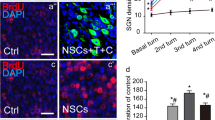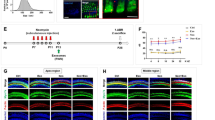Abstract
Ischemia-reperfusion injury (I/R)-induced inflammatory process can mediate cochlea damage-related hearing loss; whether cochlear spiral ganglion progenitor cell-derived exosomes (CSGPC-exos) play a protective role by carrying functional microRNAs into recipient cells is unknown. Different doses of CSGPC-exos (0.1 μg/μl, 0.2 μg/μl, 0.5 μg/μl, 1.0 μg/μl) were administrated into the cochleae of the I/R group induced with 30-min occlusion of the bilateral vertebral arteries and sham surgery group. The speech-evoked auditory brainstem response (ABR) test was utilized to estimate the auditory threshold shift. The relative expression of proinflammatory cytokines was detected with RT-PCR and Western blot, while parvalbumin and caspase-3 expression were detected by immunofluorescence staining in the cochleae. The relative expression of microRNAs (miR-21-5p, miR-26a-5p, and miR-181a-5p) was detected in the cochleae. I/R significantly up-regulated ABR threshold shift and promoted hair cell apoptosis indicated by parvalbumin and caspase-3 staining, while CSGPC-exos (0.5 μg/μl, 1.0 μg/μl) could diminish such damages with downregulated proinflammatory factors (IL-6, IL-1β, TNF-α, and Cox-2) and upregulated anti-inflammatory miRNAs (miR-21-5p, miR-26a-5p, and miR-181a-5p) expression in the cochleae. CSGPC-exos could protect cochleae damage from I/R, probably via inhibiting the inflammatory process.







Similar content being viewed by others
References
Aghaei M, Motallebnezhad M, Ghorghanlu S, Jabbari A, Enayati A, Rajaei M, Pourabouk M, Moradi A, Alizadeh AM, Khori V (2019) Targeting autophagy in cardiac ischemia/reperfusion injury: a novel therapeutic strategy. J Cell Physiol 234:16768–16778
Bian B, Zhao C, He X, Gong Y, Ren C, Ge L, Zeng Y, Li Q, Chen M, Weng C, He J, Fang Y, Xu H, Yin ZQ (2020) Exosomes derived from neural progenitor cells preserve photoreceptors during retinal degeneration by inactivating microglia. J Extracell Vesicles 9:1748931
Brodie A, Smith B, Ray J (2018) The impact of rehabilitation on quality of life after hearing loss: a systematic review. Eur Arch Otorhinolaryngol 275:2435–2440
Carricondo F, Romero-Gómez B (2019) The cochlear spiral ganglion neurons: the auditory portion of the VIII nerve. Anat Rec (Hoboken) 302:463–471
Chandrasekhar SS, Tsai Do BS, Schwartz SR, Bontempo LJ, Faucett EA, Finestone SA, Hollingsworth DB, Kelley DM, Kmucha ST, Moonis G, Poling GL, Roberts JK, Stachler RJ, Zeitler DM, Corrigan MD, Nnacheta LC, Satterfield L (2019) Clinical practice guideline: sudden hearing loss (update). Otolaryngol Head Neck Surg 161:S1-s45
Chen C, Shi G, He M, Song X, Cheng X, Wang B, Gu H, Liang X, Yu S (2019a) Characteristics and prognosis of idiopathic sudden sensorineural hearing loss in aged people: a retrospective study. Acta Otolaryngol 139:959–965
Chen Y, Zhang S, Chai R, Li H (2019b) Hair cell regeneration. Adv Exp Med Biol 1130:1–16
Diensthuber M, Zecha V, Wagenblast J, Arnhold S, Edge AS, Stöver T (2014) Spiral ganglion stem cells can be propagated and differentiated into neurons and glia. Biores Open Access 3:88–97
Elliott KL, Fritzsch B, Duncan JS (2018) Evolutionary and developmental biology provide insights into the regeneration of organ of Corti hair cells. Front Cell Neurosci 12:252
Francis A, Baynosa R (2017) Ischaemia-reperfusion injury and hyperbaric oxygen pathways: a review of cellular mechanisms. Diving Hyperb Med 47:110–117
Guo Z, Yu S, Chen X, Ye R, Zhu W, Liu X (2016) NLRP3 is involved in ischemia/reperfusion injury. CNS Neurol Disord Drug Targets 15:699–712
György B, Sage C, Indzhykulian AA, Scheffer DI, Brisson AR, Tan S, Wu X, Volak A, Mu D, Tamvakologos PI, Li Y, Fitzpatrick Z, Ericsson M, Breakefield XO, Corey DP, Maguire CA (2017) Rescue of hearing by gene delivery to inner-ear hair cells using exosome-associated AAV. Mol Ther 25:379–391
He Z, Guo L, Shu Y, Fang Q, Zhou H, Liu Y, Liu D, Lu L, Zhang X, Ding X, Liu D, Tang M, Kong W, Sha S, Li H, Gao X, Chai R (2017) Autophagy protects auditory hair cells against neomycin-induced damage. Autophagy 13:1884–1904
Kalogeris T, Baines CP, Krenz M, Korthuis RJ (2016) Ischemia/Reperfusion Compr Physiol 7:113–170
Kersigo J, D’Angelo A, Gray BD, Soukup GA, Fritzsch B (2011) The role of sensory organs and the forebrain for the development of the craniofacial shape as revealed by Foxg1-cre-mediated microRNA loss. Genesis 49:326–341
Kuhn M, Heman-Ackah SE, Shaikh JA, Roehm PC (2011) Sudden sensorineural hearing loss: a review of diagnosis, treatment, and prognosis. Trends Amplif 15:91–105
Laubach VE, Sharma AK (2016) Mechanisms of lung ischemia-reperfusion injury. Curr Opin Organ Transplant 21:246–252
Li JN, Chen S, Zhai L, Han DY, Eshraghi AA, Feng Y, Yang SM, Liu XZ (2017) The advances in hearing rehabilitation and cochlear implants in China. Ear Hear 38:647–652
Liu W, Wang X, Wang M, Wang H (2019) Protection of spiral ganglion neurons and prevention of auditory neuropathy. Adv Exp Med Biol 1130:93–107
Onal M, Elsurer C, Selimoglu N, Yilmaz M, Erdogan E, Bengi Celik J, Kal O, Onal O (2017) Ozone prevents cochlear damage from ischemia-reperfusion injury in guinea pigs. Artif Organs 41:744–752
Roccio M, Senn P, Heller S (2020) Novel insights into inner ear development and regeneration for targeted hearing loss therapies. Hear Res 397:107859
Slegtenhorst BR, Dor FJ, Rodriguez H, Voskuil FJ, Tullius SG (2014) Ischemia/reperfusion injury and its consequences on immunity and inflammation. Curr Transplant Rep 1:147–154
Soares ROS, Losada DM, Jordani MC, Évora P, Castro ESO (2019) Ischemia/Reperfusion Injury Revisited: An Overview of the Latest Pharmacological Strategies. Int J Mol Sci 20
Tabuchi K, Nishimura B, Tanaka S, Hayashi K, Hirose Y, Hara A (2010) Ischemia-reperfusion injury of the cochlea: pharmacological strategies for cochlear protection and implications of glutamate and reactive oxygen species. Curr Neuropharmacol 8:128–134
Wang J, Puel JL (2018) Toward cochlear therapies. Physiol Rev 98:2477–2522
Wu MY, Yiang GT, Liao WT, Tsai AP, Cheng YL, Cheng PW, Li CY, Li CJ (2018) Current mechanistic concepts in ischemia and reperfusion injury. Cell Physiol Biochem 46:1650–1667
Yamoah EN, Li M, Shah A, Elliott KL, Cheah K, Xu PX, Phillips S, Young SM Jr, Eberl DF, Fritzsch B (2020) Using Sox2 to alleviate the hallmarks of age-related hearing loss. Ageing Res Rev 59:101042
Yang H, Pang J, Xiong H, Sun Y, Lai L, Chen S, Ye Y, Yang Z, Zheng Y (2017) The protective effect of autophagy on ischemia/reperfusion-induced hearing loss: implications for sudden hearing loss. NeuroReport 28:1157–1163
Zakrzewski W, Dobrzyński M, Szymonowicz M, Rybak Z (2019) Stem cells: past, present, and future. Stem Cell Res Ther 10:68
Funding
The study was supported by the National Science Foundation of China (81600811) and Innovation Program of Hunan Technology (2018SK52513).
Author information
Authors and Affiliations
Corresponding author
Ethics declarations
Ethical approval
All the operation was approved by the Ethical Committee of Xiangya Hospital.
Conflict of interest
The authors declare no competing interests.
Additional information
Publisher's Note
Springer Nature remains neutral with regard to jurisdictional claims in published maps and institutional affiliations.
Rights and permissions
About this article
Cite this article
Yang, T., Cai, C., Peng, A. et al. Exosomes derived from cochlear spiral ganglion progenitor cells prevent cochlea damage from ischemia-reperfusion injury via inhibiting the inflammatory process. Cell Tissue Res 386, 239–247 (2021). https://doi.org/10.1007/s00441-021-03468-x
Received:
Accepted:
Published:
Issue Date:
DOI: https://doi.org/10.1007/s00441-021-03468-x




